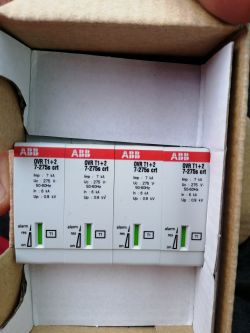FAQ
TL;DR: For TN‑C‑S, size your Type 1+2 SPD correctly—20 kA beats 7 kA; "this limiter is not suitable" if underrated. This FAQ clarifies PEN splitting and 4‑pole SPD connections so you wire it right. [Elektroda, mawerix123, post #17935480]
Why it matters: Picking the wrong SPD type or wiring PEN/PE/N incorrectly leaves your installation exposed and can damage equipment.
Quick facts:
- Use a TN‑C SPD before the PEN split; use a 4‑pole 3+1 SPD after the split in TN‑C‑S. [Schneider Electric, 2018]
- With overhead feeders or LPS, place a Type 1+2 SPD at the service entrance; verify if your DSO already provides Type 1. [ABB, 2018]
- Keep total SPD lead length ≤ 0.5 m; each extra 0.5 m can add approx. 1 kV at 10 kA. [DEHN, 2017]
- SPDs do not protect against a broken PEN on an overhead line; plan PEN monitoring and solid earthing. [Elektroda, CYRUS2, post #17936144]
- Typical retail examples mentioned: combined T1+T2 SPD ~ PLN 250–500. [Elektroda, semper fidelis1, #17935532]
Quick Facts
- Use a TN‑C SPD before the PEN split; use a 4‑pole 3+1 SPD after the split in TN‑C‑S. [Schneider Electric, 2018]
- With overhead feeders or LPS, place a Type 1+2 SPD at the service entrance; verify if your DSO already provides Type 1. [ABB, 2018]
- Keep total SPD lead length ≤ 0.5 m; each extra 0.5 m can add approx. 1 kV at 10 kA. [DEHN, 2017]
- SPDs do not protect against a broken PEN on an overhead line; plan PEN monitoring and solid earthing. [Elektroda, CYRUS2, post #17936144]
- Typical retail examples mentioned: combined T1+T2 SPD ~ PLN 250–500. [Elektroda, semper fidelis1, #17935532]
Is a 4‑pole SPD correct in a TN‑C‑S board after the PEN split?
Yes. After splitting PEN to PE and N, use a 4‑pole (3+1) SPD. Connect L1, L2, L3, and N to the SPD, and SPD PE to the main earthing bar. Place it near the main switch. Keep leads very short. [Schneider Electric, 2018]
Should I connect the N pole of the SPD if N is bonded to PEN at the split?
Yes. After the split, N and PE are separate conductors. The N pole is essential in a 3+1 topology to clamp neutral transients to PE. Without N, neutral overvoltages are not controlled. Before the split (TN‑C), use a TN‑C SPD. [Schneider Electric, 2018]
Is a 7 kA SPD enough for a house with overhead supply?
No. 7 kA devices are undersized at the service entrance. Typical service-entry SPDs use higher surge ratings. As one pro noted, "this limiter is not suitable." Aim for significantly higher kA capability for durability. [Elektroda, mawerix123, post #17935480]
Will an SPD protect against a broken PEN on an overhead line?
No. A broken PEN causes dangerous neutral shifts that SPDs cannot correct. Equipment can still be damaged. Use PEN monitoring and robust earthing to mitigate this risk. SPDs address surge energy, not conductor continuity. [Elektroda, CYRUS2, post #17936144]
Should PE go first to the SPD and then to the PE bar?
Connect the SPD directly to the main earthing bar with the shortest, straightest path. Then bond the PE bar to that bar. Short leads reduce added voltage; every extra 0.5 m can add approx. 1 kV at 10 kA. [DEHN, 2017]
What do the labels B, C, and T1/T2 mean (B+C vs T1+T2)?
B means Type 1. C means Type 2. A combined device marked B+C is a Type 1+2 SPD. Use combined units at service entrances to cover both lightning and switching surges. ABB and others label this clearly. [ABB, 2018]
Which SPD topology for TN‑C vs TN‑C‑S networks?
In TN‑C before the split, use a 3‑pole SPD connected to L1‑L2‑L3‑PEN. In TN‑C‑S after the split, use a 4‑pole 3+1 device connecting L1‑L2‑L3‑N to PE. Follow the device’s topology diagram. [Schneider Electric, 2018]
Do I need Type 1 if I don’t have a lightning protection system (LPS)?
Overhead feeds and service masts can conduct direct surge energy. Use a Type 1+2 at the service entrance unless the DSO already provides Type 1 upstream. If provided, a Type 2 downstream can suffice. Verify in writing. [ABB, 2018]
C25 vs D25 upstream protection—what should I use?
D‑curve can improve short‑circuit selectivity at the same current rating. However, your DSO specifies the main protective device. "It is not the author who specifies the type of security." Coordinate changes with them. [Elektroda, retrofood, post #17936156]
How should I bond the SPD to a ring earth electrode?
Bond the SPD to the main earthing bar that connects to the ring electrode. Use a short, straight conductor with adequate cross‑section (typical 16 mm² Cu). Avoid loops and sharp bends. Keep total SPD connection length ≤ 0.5 m. [DEHN, 2017]
How do I install a combined Type 1+2 SPD at the main board?
- Split PEN to PE and N on the main bar, bonded to the earthing electrode.
- Mount the 3+1 SPD near the main switch; connect L1‑L2‑L3‑N in, PE to the earthing bar.
- Keep all SPD leads short and straight; verify tightening torques.
[ABB, 2018]
How do I confirm I’m using the right SPD and wiring?
Always follow the manufacturer’s diagrams and notes for your network type. "Each protector is supplied with the manufacturer's instructions." Check topology, conductor sizes, and placement before energizing. [Elektroda, retrofood, post #17935714]





